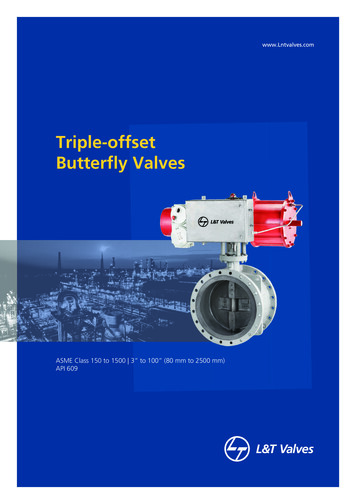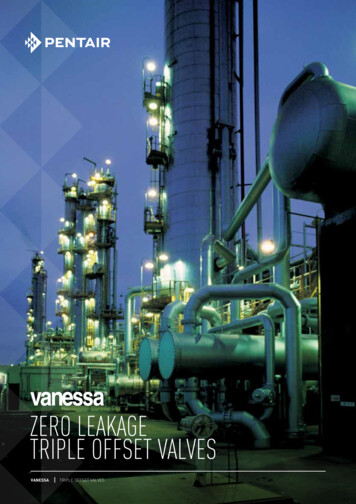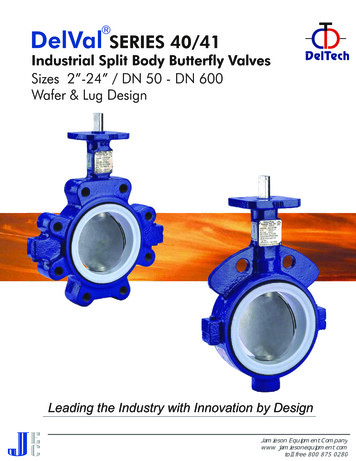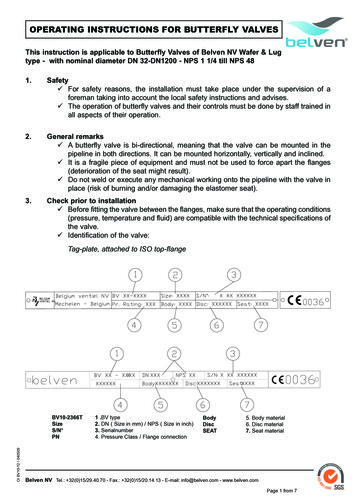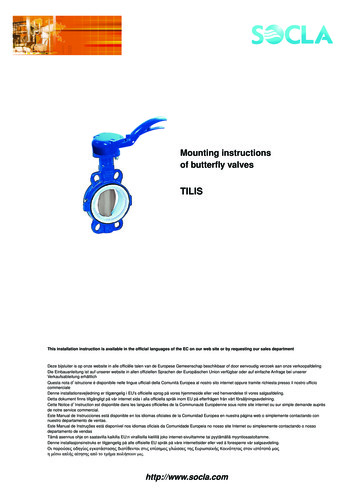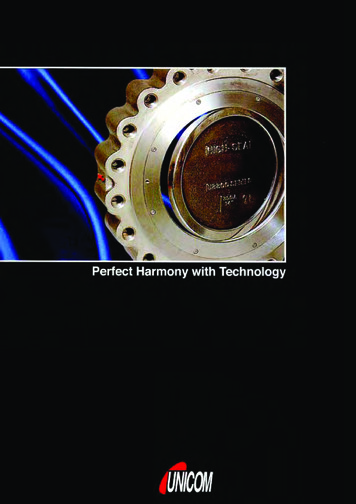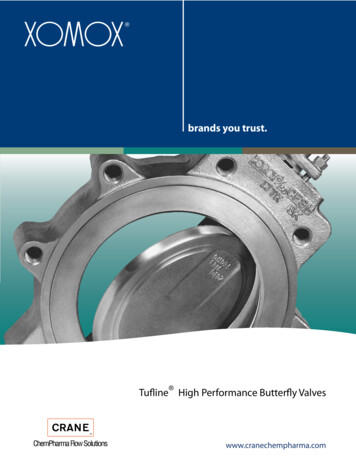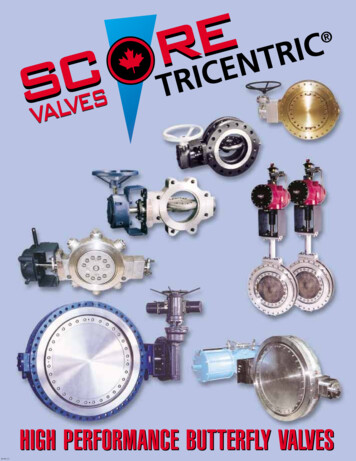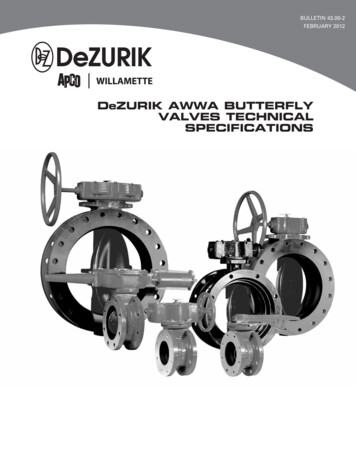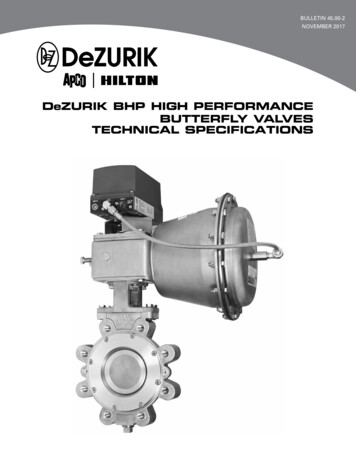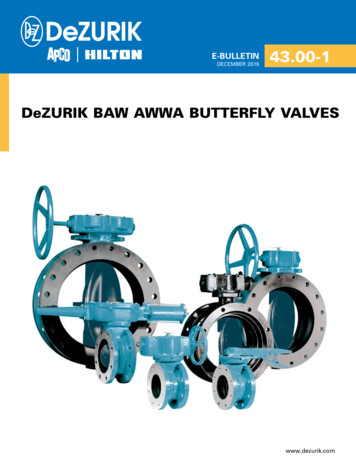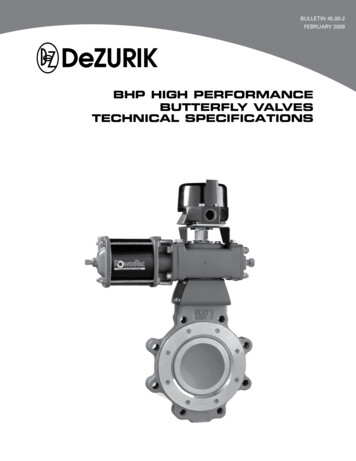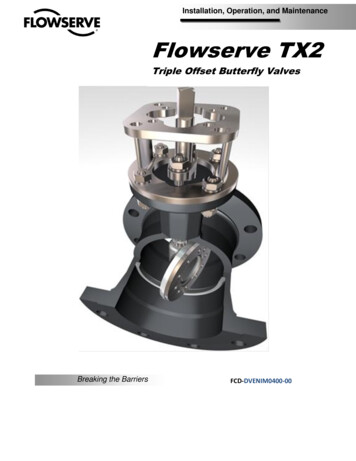
Transcription
Installation, Operation, and MaintenanceFlowserve TX2Triple Offset Butterfly ValvesBreaking the BarriersFCD-DVENIM0400-00
Flow Control DivisionTABLE OF XVIXVIIXVIIITITLEFOREWORDTHEORY OF OPERATIONPRELIMINARY PRECAUTIONSINSPECTIONTOOL REQUIREMENTSTORAGEINSTALLATIONSTEPS OF INSTALLATIONFLANGE CONNECTING AND BOLTINGREMOVAL PROCEDURELUBRICATION SCHEDULESTUFFING BOX MAINTENANCE PROCEDURECHANGE OF DISC AND BODY SEATCHANGE OF GASKETASSEMBLY AND DISASSEMBLYPARTS AND SERVICETROUBLESHOOTING GUIDECAUTIONSPARTS LIST AND serve Corporation, Flow Control Division, has established this Installation, Operating andmaintenance Manual to facilitate field installation, operation and repair of Flowserve TX2 TripleOffset Butterfly ValvesIt is recommended that questions or concerns involving the processes described in this manual bedirected to the local Sales Representative of Flowserve Corporation. Only Flowservereplacement repair parts should be used. Part numbers referenced in the following sections areavailable from Flowserve Corporation, Flow Control Division.2
Flow Control DivisionSECTION ITHEORY OF OPERATIONThe valve design is based on a double eccentric geometry of the disc rotating center, utilizing a floatingradius machined seal ring, in conjunction with an inclined cone seating surface of body. This designmakes the disc cam back and away from body seat, eliminating wear between the seat and seal ring. Italso compensates for deviations of the geometry caused by temperature or tolerance changes. (Fig. 1)The disc seal of valve deflects from its regularly circular shape to an elliptic form when it reaches theclosed position. This matches the inclined cone of body seat geometry, creating the sealing between discseal and body seat. Dimension changes due to temperature fluctuations cause the seal ring to adjust itsseating position within the inclined cone geometry, thus maintaining a positive seal as usual.Due to the unique conical surface of the valve, there is a “preferred” and “non-preferred” flow direction.The preferred flow direction would be with the shaft upstream and the direction is marked on the bodywith a directional arrow. The shaft side is referred to as the high pressure side of the valve.Preferreddirection of flowSECTION IIPRELIMINARY PRECAUTIONSFOR SAFETY, FOLLOW THESE CAUTIONS BEFORE INSTALLING, REMOVING ORDISASSEMBLING YOUR VALVE.1. MUST KNOW WHAT MEDIA IS IN THE PIPELINE.2. MAKE SURE THE LINE IS DEPRESSURIZED.3. USE PROTECTIVE CLOTHING AND EQUIPMENT TO AVOID INJURY. KEEP HANDS ANDOTHER BODY PARTS OUT OF THE VALVE.4. ALWAYS ENSURE THE VALVE IS IN THE FULLY CLOSED POSITION BEFOREINSTALLATION, REMOVAL OR DISASSEMBLY.5. ENSURE THAT FLANGE FACES ARE CLEAN BEFORE INSTALLATION IN PIPELINE.3
Flow Control DivisionSECTION IIIINSPECTION1. Before installation of the valve into the piping system, visually inspect the valve to determineif any damage has occurred during shipping. Particularly, inspect the actuator, shaft, valveinterior, valve body and flanges. For proper operation of the valves, the seat and disc sealmust be undamaged and free of foreign material. If other than superficial damage isdiscovered, contact Flowserve immediately, indicating the location and extent of the damagefound.2. If it is necessary to clean the valve, use a soft cloth and mineral spirits, or an equivalentsolvent. All rust preventive should be removed before installing your valve.SECTION IVTOOL REQUIREMENTThere are no special tools required for installation and maintenance that are not commercially available.Any lifting devices used to move the valve into a desired position shall be of sufficient size to support theweight of the valve and actuator assembly. Nylon slings secured around the valve bearing areas arerecommended to reduce the possibility of mechanical damage occurring to the valve body and actuator.The assembly should never be lifted by the actuator. (Fig.2)Fig. 2WARNINGNEVER pass a lifting device through the valve port or severe damage mayoccur.4
Flow Control DivisionSECTION VSTORAGEWhen the valve is not put into immediate service, it is required that the valve be stored in a heated building that isfire resistant, weather tight and well ventilated. Storage area shall be situated and constructed so that it will not besubject to flooding or the presence of any corrosive chemicals. Flowserve recommends that all valve actuators becycled approximately every 60 days or as required by the manufacturer of the actuation system. Any spare parts forthe valve shall be stored in the original packaging and under the same conditions as the valve will be stored. Forstorage greater than 4 months, the storage container should be inspected every four (4) months to ensure it is in goodcondition, and any additional protective coverings or materials are in working order. Ensure all parts are plugged,and bare metal is covered with a suitable rust inhibitor.SECTION VIINSTALLATIONThe valve must be installed so that pipeline stresses are not transmitted to the valve body. Despite its solidmanufacture, such stress may affect valve operation. If pipeline stresses are severe, they should be cushioned byexpansion joints or compensators. If supports are necessary for the valve, they should only support the dead weightof the valve and should not serve as base points for the pipeline.SECTION VIISTEPS OF INSTALLATION7.1. All valve s must be in full closed position during installation or removal. It is not necessary to torqueseat the valve, but the disc travel must be restricted to prevent damage.7.2. Please be sure there is no foreign material and that it is clean inside of the pipe and valve.7.3. The shaft side of the disc is considered the high-pressure side of the valve, (as indicated on thedrawings by a flow arrow) meaning the best closure performance is obtained on this side of the valve, and adetermination as to the best installation should be made, to utilize this feature. This may not necessarily bethe normal flow direction of the system. (Fig.3).7.4. Please install the valve stem horizontally as (Fig.4), thus could prevent sand and some chips fromcollecting around bottom bushing and seat. Such reside could damage the valve.Fog 4Fig 4Fig 4Fig 35
Flow Control Division4.5. Install valve and gaskets into pipeline as (Fig.5).Fig 6Fig 54.6. Make sure that the valve is installed concentrically between the flanges in order to couldprevent the disc from being damaged by interference with the flange and pipeline (Fig.6)4.7. The typical installation for a butterfly valve connected to an elbow would be to align theshaft axis to allow equal flow on each side of the shaft, minimizing dynamic torque requirementsfor the valve. (Fig.7)ExcellentGoodNot recommendedFig 74.8. Always use an extension tube between wafer check valve and butterfly valve. Neverconnect them directly. (Fig.8)Fig 86
Flow Control DivisionSECTION VIIIFLANGE CONNECTING & BOLTING8.1. Keep valve protection boards until installation.8.2. Make sure the material and size of gaskets could be suitable for the service. Ensure that the faces of flange andvalve are smooth and flat. Sandpaper the faces if there are any defects.8.3. Check that all the bolts and nuts are in good condition.8.4. Apply lubricant such as Molybdenum to all the bolts and nuts before fixing them.8.5. The pipe support(s) may now be required to be partially disengaged. A determination as to pipe flangealignment and space between the pipe flange and the valve face must be made at this time. The optimum spacingwould be such as to only allow the flange gasket to be installed, at the maximum, and the flange bolt holes would beconcentric.8.6. The opposite connecting pipe flange face may not be more than 1/4 inch away from the valve flange face.Alternate methods of alignment, other than using the flange bolts, must be utilized to conform with this requirement.8.7. Install all studs, maintaining uniform clearance between the studs and the mating bolt holes. Additionally thestuds spanning the valve assembly should not contact the valve body.8.8. Seat the flange by alternate tightening of four equally-spaced flange bolts no more than 1/4 turn per bolt, untilthe flange faces seat. During this operation, it is advisable to continually check the relative distance between theflange faces. Torque the bolts to approximately 25% of the final torque value (see table 1).8.9. Inspect the remaining bolts and assure correct alignment. Tighten to the same level as the first four bolts.8.10. Complete the tightening of all flange bolting in a minimum of four increments to the final determined torquevalue.8.11. Test cycle the valve to be sure that there is no interference or binding.12. Maximum Torque of Flange BoltBolt size5/8” (M16)3/4” (M20)7/8” (M22)1” 320480600840(Nm)1502704346508151140Table 1.※Actual torque shall depend on gaskettype, consult gasket manufacturer.BOLT TIGHTENING SEQUENCE (Fig.9)7
Flow Control DivisionSECTION IXREMOVAL PROCEDURETo remove your valve from the pipeline, please follow these simple steps:Ensure that the valve is in the closed position.Ensure that the line is depressurized.Use protective clothing and equipment to prevent injury.If your valve is equipped with a fail-open actuator, manually close the valve or disconnect the actuator then closethe valve before removal.Attach nylon slings to the body shoulders of the valve and around the body of the actuator.Remove the bolts holding the valve to the pipeline flanges.SECTION XLUBRICATION SCHEDULEFlowserverecommends that your valve be inspected at least every three months to determine lubrication and othermaintenance requirements dependign upon your specific service conditions.SECTION XISTUFFING BOX MAINTENANCE PROCEDURERoutine maintenance of the stuffing box consists of tightening the packing gland periodically. If leakage around thestuffing box is discovered, first tighten the hex-nuts on the gland follower (more than 2/3 compression) as this mayreduce packing life. If the leakage still persists, replace the packing according to the following procedure. (Forclarity, the actuator and bracket are not shown in the following diagrams. It is not necessary to remove the actuatoror bracket before performing this procedure).11.1 In order to gain access to the packing, remove the gland follower and slide it up to the actuator. See the diagrambelow:Fig 108
Flow Control Division11.2 Remove all of the packing in the stuffing box using a flexible screw hook. For stuffing boxes thatcontain a lantern ring, use a puller with 10-32 threads to remove the lantern ring. Save the lantern ring forreuse, but discard the other packing material. Please replace all the gland packing no matter the glandpacking is made of Graphite. (Fig.11)Fig.1111.3 Inspect the drive shaft, bore of the stuffing box, and the gland follower. These surfaces should be relativelyscratch free. If there is any damage, polish the surface to 32 rms finish (Fig.13). If any part has severe damage,contact your Flowserve representative.Fig.139
Flow Control Division11.4 Install each new ring of packing, use the glandfollower to push each ring of packing evenly intoposition after starting it in the stuffing box bore.Stagger the splice-joints of each packing ring so theyare as far as possible from each other (see exampleabove). Usually, rotating each ring until the splice isat 90 from the previous splice is sufficient. (Fig.14)Fig 1411.5 Install the gland follower and tighten it to firmly seat the packing. DO NOT compress the gland follower toomuch. Over-tightening may dramatically reduce the life of the packing and may make it more difficult to operate thevalve. The maximum torque of the gland screw as below,Graphite PackingScrew SizeMax. Kg-cmKg-cm10
Flow Control DivisionSECTION XIICHANGE OF DISC AND BODY SEAT12.1 To facilitate reassembly, mark the positon of the operator, yoke and body mounting flangebefore disassembling (Fig. 15)Fig 1512.2 For reassembly, make a mark on the retainer and disc before disassembling.12.3 Turn the stem counterclockwise around 180 (Fig. 16in order to make it easier to loosen and remove the boltsand take off the retainer, gasket and disc seat.Fig.1612.4 Loosen all bolts from the retainer by hexagonal wrench.12.5 Take off the retainer, disc seat and gasket (seal-3) in sequence.12.6 The replacement of body seat is available for Class 300 and 600 valves Class 150 valve bodieshave a one piece design.12.7 To make a mark for reassemble on the body and body seat before replacing the body seat.11
Flow Control Division12.8 Loosen all bolts from body seat by hexagonal wrench.12.9 Remove the body seat and gasket (seal-4) in sequence.12.10 Clean the body seat and all components of body, disc and retainer.12.11 Put a new gasket (seal-4) into the groove of the body seat. (Fig. 17)SEAL-4Fig.1712.12 Please refer to Fig.18 for assembling the body seat.The straight side ofbody seat on the leftThe inclined side of bodyseat on the right sideFig.1812.13 Screw the bolts into the holes of body seat and tighten the bolts in a diagonal sequence12
Flow Control Division12.14 Please refer to Fig.19 for putting new gasket (seal-3) into the disc groove.SEAL-3Fig.1912.15 Please refer to Fig. 20 for assembling the retainer and disc seat. Firstly, put back the boltsinto the holes of retainer and tighten the bolts slightly. After turning the disc clockwise towardsthe closing direction, turn around the valve and tighten the bolts in a diagonal sequence.The straight side ofdisc seat andretainer on the leftThe inclined side ofdisc seat andretainer on the rightsideFig 2013
Flow Control DivisionSECTION XIIICHANGE OF GASKET13.1 Loosen and remove the bolts from the body bottom cover and take off the bottom cover andgask
Offset Butterfly Valves It is recommended that questions or concerns involving the processes described in this manual be directed to the local Sales Representative of Flowserve Corporation. Only Flowserve replacement repair parts should be used. Part numbers referenced in the following sections are available from Flowserve Corporation, Flow Control Division. Flow Control Division 3 SECTION I .
